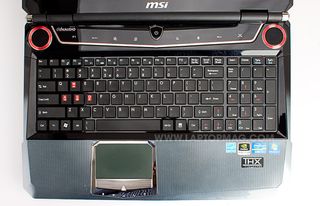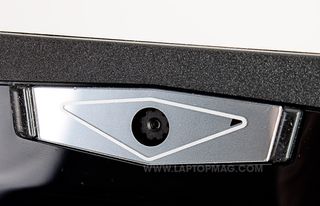Laptop Mag Verdict
MSI combines power, good sound quality, and fun LED lights in its GT680R gaming notebook.
Pros
- +
Fast gaming performance
- +
Dynaudio-powered speakers
- +
Full HD display
- +
LED lighting
- +
Effective cooling fan
Cons
- -
Keyboard flexes
- -
Weak wireless range
- -
Fan gets loud
Why you can trust Laptop Mag
Last year's MSI GT660 impressed with its quad-core power, fun and customizable lighting effects, and loud speakers. However, that system lacked a full HD display and cost a pretty penny ($1,849). With the GT680R-008US, MSI has added a 1080p screen, a faster Sandy Bridge Core i7 CPU, and beefier Nvidia Geforce GTX 460M graphics fully capable of delivering DirectX 11 eye candy. You also get a full terabyte of storage. Asking price? Just $1,499. So just how much more notebook are you getting for the money?
Design
The GT680 has the same chassis and design as the GT660, which we reviewed last year. Aesthetically, there's a lot going on--almost too much. The lid has some funky angles cut along the edges and a glossy, beveled lid complete with a glowing MSI logo. Under the hood there's a mix of matte and glossy textures--though the latter dominates--and the piano black of the display bezel and top of the deck fades into a glossy slate color, which then turns into a textured honeycomb pattern on the palm rest.
Two speakers ringed in red sit on the left and right of the upper deck, and between them is a control deck outlined in red and chrome with touch-sensitive LEDs. A light tap activates each function, including enabling or disabling Bluetooth, Wi-Fi, or the Windows key and switching between power modes. There's even a programmable shortcut button, though we wish dedicated media controls were here as well. A shield-shaped power button sits in the center. Though we found this strip very useful, it picked up fingerprints.
The 15.6 x 10.5 x 2.2-inch GT680R is portable enough to take to a LAN party, but its 7.6-pound weight will likely keep it sitting on your desk most of the time. Nevertheless, this notebook is 2 pounds lighter than the 17-inch Alienware M17x.

Click to enlarge
Customizable LED Lights
No gaming notebook would be complete without glowing LED accents. The GT680 sports thin bands of orange LEDs along the lower edges of the lid and around the edge corners at the bottom of the deck. We don't like that the color doesn't quite match the red accents splashed across the keyboard and the top edge, but it was cool that we could turn the LED accents completely on or off by tapping the icon on the far right of the control deck.
Click to enlarge
With the MSI LED Manager utility, you can turn each area on and off individually or all of them on or off completely. Users can also set the LEDs to "breathe," which results in a gentle fade in and out, or to pulse along with the audio coming from your speakers. This latter feature was a lot of fun when we began playing loud, drum-driven music. Overall, it's not as comprehensive as the LEDs on Alienware systems, but it's a nice touch.
Keyboard and Touchpad
Since the keys on the GT680R aren't backlit, you won't be able to game as easily with the lights dimmed. Still, we appreciated the red accents on the keys most games default to for movement--WASD, 8462, and arrows--making them easier to find.

Click to enlarge
The keyboard is (mostly) full-size, but the deck is springy and keys don't have much depth, so we found ourselves making more typing errors than usual. Oddly, the right Shift key is shrunken. Plus, there's an extra backslash key between the small Alt key on the left and the space bar. This made executing keyboard shortcuts hard because the Alt key isn't where our fingers expect it.
The GT680R's touchpad is large enough (3.2 x 2 inches) and features a slightly rough-touch surface for easy navigation. Though the mouse buttons are technically a single bar, a divot in the middle helps separate the left and right sides, and we had no issues using them.
Heat
To measure the GT680R's heat under normal usage, we played a Hulu video at full screen for 15 minutes. The space between the G and H keys only reached 82 degrees Fahrenheit, and the touchpad got up to 81 degrees. The middle of the underside stayed a cool 89 degrees. Near the vent we measured 101 degrees, which is above our comfortable zone. After gaming for 30 minutes, temperatures near the vent and on bottom of the notebook in that corner ranged from 110 to 122 degrees.
Luckily, MSI includes a Cooler Boost function. Just press the icon on the strip at the top of the deck and the fan inside the notebook will go from normal to high speed. In less than 10 minutes, the same area cooled to between 89 and 94 degrees. The fan is fairly noisy, but at least MSI gives users this cooling option.
Ports and Webcam
On the left of the GT680R you get two USB 3.0 ports, a USB 2.0 port, and a memory card slot. To keep costs down, this model ditches the Blu-ray drive for a DVD SuperMulti Drive, which takes up most of the right edge, but there's still room for the other USB port, headphone, mic, audio in, and audio out ports. Finally, the eSATA, HDMI, VGA, Ethernet and power ports sit in the center of the notebook's back edge.

Click to enlarge

Click to enlarge
The webcam on the GT680R is a high-end unit that can capture video in HD: 1280 x 720, 30 fps. Video quality at this size wasn't stunning, but once we adjusted the settings (brightness, hue, saturation, etc.), the resulting images were decent.

Click to enlarge
Display & Audio
We're glad that the GT680R's 15.6-inch display offers a full HD, 1920 x 1080 resolution, something the earlier GT660 lacked. The glossy screen still offers deep blacks and popping colors, but the reflections and glare are somewhat distracting while watching video or surfing the web.
As with the GT660, the GT680R has speakers designed by Dynaudio, a high-end audio company from Denmark. The two speakers on the upper left and right of the GT680R's deck produce powerful volume and better sound than you'll find on a typical notebook, but their placement has some drawbacks. We appreciated the true stereo output; while playing games it helped us hear which direction enemy fire came from. However, locating the speakers so close to the screen caused sound to reflect off the display, making audio mush together.
Click to enlarge
Though the audio was definitely strong (at 70 percent we could fill a medium-sized room), the GT680R lacked clarity in the midrange. Thanks to the sub-woofer on the bottom, there's decent bass response, but the booms of grenades exploding while gaming were more muted than we'd like.
Performance
The GT680R features a second-generation 2.0-GHz quad-core Intel Core i7 2630QM CPU, 8GB of RAM, and a 7,200-rpm 1TB hard drive. You also get Nvidia's Geforce GTX 460M graphics with 1.5GB of dedicated video memory. These high-octane components combined to notch a score of 9,184 on PCMark Vantage. This showing is far above the desktop replacement average (6,400) and the HP Envy 17 3D (5,888), the Dell XPS 15 (8,548), and the 2011 15-inch MacBook Pro (7,648). Of course, the powerhouse Alienware M17x blows the GT680R out of the water (17,486), but it also costs more than twice as much.
MSI also includes a TurboBoost function to overclock both the CPU and GPU, so power users can squeeze even more juice out of the system at the touch of a button. To access this feature, just tap the Turbo button on the strip at the top of the deck. When it's on, the orange LED will light it up. However, since the Intel CPU can automatically overclock itself, we didn't notice a difference when running PCMark Vantage with TurboBoost activated.
The dual 7,200-rpm, 500GB hard drives (arranged in a RAID 0 array) completed the LAPTOP Transfer Test in 1 minute and 22 seconds for a speed of 62.1 MBps, almost twice the category average (34.7) and way faster than the Envy 17 3D (28.3) and the XPS 15 (33.3). Boot time into Windows 7 Home Premium was 54 seconds, about 10 seconds below average.
The GT680 easily handled multitasking and didn't slow down even when we opened 10 programs and switched between them. Transcoding a 114MB MPEG-4 file to AVI with Oxelon Media Converter took just 43 seconds, 19 seconds under the average desktop replacement.
Graphics and Gaming Performance
The GT680's Nvidia GeForce GTX 460M graphics card and 1.5GB of dedicated memory led to an impressive 13,987 score in 3DMark06, 5,600 points above average. Once again, the Envy 17 3D (10,482) and the 15-inch MacBook Pro (10,874) couldn't keep up, and neither could the Dell XPS 15 (8,101), but the Alienware M17x was miles ahead (20,048). There's a similar point spread in 3DMark Vantage, with the GT680 notching 8,400, the Envy getting 6,538, and the Alienware scoring 13,414.
The actual gaming experience lived up to the benchmarks, with the GT680 zooming along at 157 frames per second in World of Warcraft at the maximum resolution (1080p) with graphics set to Good. With all settings pumped to the max, the notebook still managed a great 81 fps. At these same settings, the GT680 approached the Alienware's quality, with the M17x scoring 191 and 107, respectively. In the more graphically intensive Far Cry 2, the GT680 still provided fast, smooth gameplay at both auto resolution (1024 x 768) and the max (136/55 fps).
When we fired up Call of Duty: Modern Warfare 2, we enjoyed frame rates of 55 to 61 fps when gaming at 1920p; that's very good, higher than the Toshiba Qosmio X505 (45 fps), though the Alienware M17x saw around 90 fps.
Battery Life and Wi-Fi
The system's nine-cell battery lasted for 4 hours and 2 minutes on the LAPTOP Battery Test (web surfing over Wi-Fi), an impressive hour and a half longer than the category average. The only recent rig that beats it is the Alienware M17x, with its 5:02 longevity.
The GT680's Intel Centrino Wireless-N b/g/n wireless radio didn't deliver very strong throughput. At 15 feet from the router, it averaged just 24.2 Mbps, and at 50 feet this dropped to 15.0 Mbps. The average desktop replacement gets 32.4 and 19.3 Mbps, respectively, and the HP Envy 17 3D is even better than that (35.4/21.3). If you're gaming online, be sure to stay close to the router.
Software and Warranty
MSI includes a few interesting pre-loaded utilities and programs. On the multimedia side, users get the MAGIX Music Maker, Photo Manager, and Video Easy. As mentioned, the THX TrueStudio Pro settings utility allows for audio tweaking. MSI's Eco Engine power management utility allows users to switch between five different power profiles based on usage: Gaming, Movie, Office, Presentation, and Turbo Battery. There's also a tool to help back up and restore the notebook should anything go wrong, and a link to remote assistance.
Click to enlarge
MSI offers a two-year limited warranty, and 1-year global warranty on the notebook. Unfortunately, the company provides phone support only from 9 a.m. to 9 p.m. (EST) on weekdays. To see how MSI did in this year's Tech Support Showdown, click here.
Verdict
The $1,499 MSI GT680R-008US is a powerful mid-size gaming rig that offers lots of performance in a fairly portable design. We wish that MSI made different choices when it came to keyboard design and speaker placement, but otherwise this system is a big improvement over the last generation. For those who prefer Alienware's design, an M17x with the same CPU and GPU, but with 4GB RAM, a 320GB hard drive, and a 1600 x 900 display will set you back $1,574. But if you want a full HD screen and a full terabyte of storage for a better price, the GT680 is a very good value.
MSI GT680R Specs
| Bluetooth | Bluetooth 2.1+EDR |
| Brand | MSI |
| CPU | 2.0GHz Intel Core i7-2630QM |
| Card Slots | 6-1 card reader |
| Company Website | http://www.msi.com/ |
| Display Size | 15.6 |
| Graphics Card | NVIDIA Geforce GTX 460M |
| Hard Drive Size | 1 TB |
| Hard Drive Speed | 7,200rpm |
| Hard Drive Type | SATA Dual Drive |
| Native Resolution | 1920x1080 |
| Operating System | MS Windows 7 Home Premium (64-bit) |
| Optical Drive | DVD SuperMultiDrive |
| Optical Drive Speed | 8X |
| Ports (excluding USB) | Ethernet, VGA, eSATA, USB 3.0, Audio-out, Microphone, Audio-in, Kensington Lock, Headphone, HDMI |
| RAM | 8GB |
| RAM Upgradable to | 16GB |
| Size | 15.6 x 10.5 x 2.2 inches |
| Touchpad Size | 3.2 x 2.0 inches |
| USB Ports | 4 |
| Video Memory | 1.5GB |
| Warranty/Support | 2-year limited warranty, 1-year global warranty. Phone support from 9 a.m. to 9 p.m. (EST) on weekdays |
| Weight | 7.6 pounds |
| Wi-Fi | 802.11b/g/n |
| Wi-Fi Model | Intel Centrino Wireless-N |
